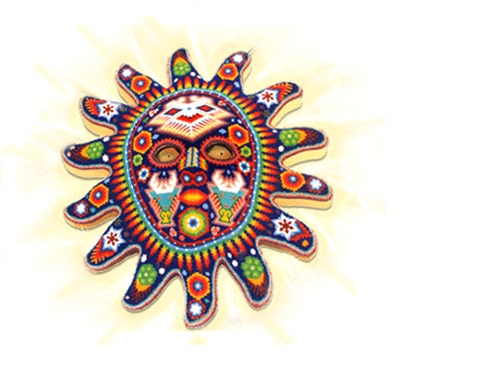When the first men became conscious of the light that was emitted from the sun, and the relationship that exists between light and day; darkness and night; the sun and the moon; they assigned them each values. The sun received the positive values: life and flourishing nature; the moon’s values were a little more negative: the world of the dead, a decline.
From the sun comes positive energy, and to him, “Tonathiu”, the highest honors are given in the festivals and traditions that come from the “life cycles” – the same cycles which are associated with the arrival of Spring.
In all of the pre-Colombian cultures, the sun is associated with the Spring rituals, when life is reborn and flourishes. It is also the time of year to prepare the fallow land for harvest. In the “huichol” pueblos, a ritual is prepared for the “deer”, which is the sun that carries light to the pueblos throughout the three-day celebration.
The figure of the sun is even present in the roundness of our Mexican tortilla, which nourishes and provides energy for our body. The form of the tortilla – round — and the corn – yellow like the sun – bring together symbolic elements of the positive values.
The Pre-Hispanic cultures took advantage of the light of the sun, converting into energy for their own bodies. They would rub their hands together vigorously, and then expose their hands to the sun of the heavenly star for several minutes, sitting on the ground with their legs crossed in the lotus position.
In archaeological centers across the world, it has become a tradition for the people to receive the equinox. As the pyramids attract energy, people arrive dressed in white, ready to receive the forces of the sun. Many arrive early in the morning, climb the pyramids, and find a good place to receive the energy. Some wear flower necklaces; others wear red handkerchiefs around their foreheads; and those who are the most deeply rooted in the tradition light incense and walk in huaraches or go barefoot along the edifying rocks.
The force of the sun can not be diminished by anyone, not even by its antagonist – the moon. If it could, life, goodness, and a growing and flourishing nature would all come to an end. Therefore, when there is a solar eclipse, indigenous villages come to the sun’s defense, and through dance, prayer, and many diverse rituals, they protect the sun from the moon. The triumph comes when, according to the tradition, they manage to drive away the “meztli” – the traitor moon which leaves after he is kept from eating the sun.
The sun…luminous life that gives heat and is represented in all sorts of clay forms, copper, murals, bracelets, necklaces; in the treasure of “Olinalá” and in the belts of “Quiroga”…the sun, which belongs to everyone…the same as always.


